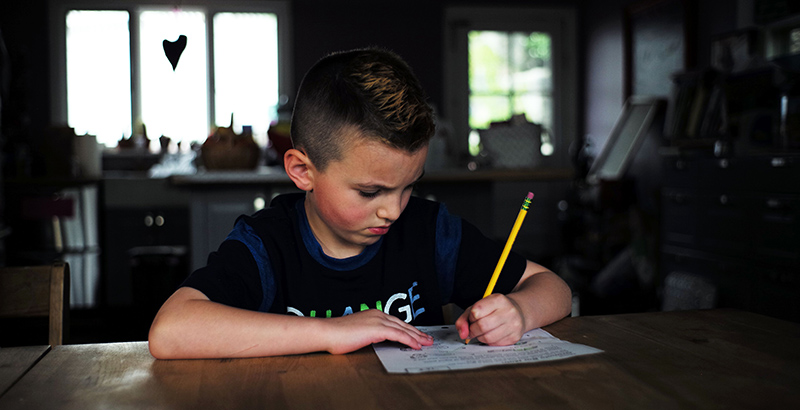Many Rural Remote Learners Are Receiving Little to No Live Teaching, Federal Survey Reveals

More students than previously understood may be attending school virtually, survey data released Wednesday by the U.S. Department of Education reveal. And many students — particularly remote learners from rural schools — are getting little to no live instructional time with teachers.
While the survey finds that over three-quarters of elementary and middle schoolers attend schools that offer at least some classroom learning, a smaller share of students have actually opted into in-person classes. As of late January and early February of this year, 43 percent of fourth-graders and 48 percent of eighth-graders were learning virtually, according to the new data.
Within the eighth-grade cohort of remote learners, 1 in 10 weren’t getting any live instruction from a teacher at all, and another 6 percent were receiving less than an hour per day.
At rural and town middle schools, 13 and 16 percent of virtual learners respectively were receiving no live teaching, compared to only 3 and 4 percent of their urban and suburban counterparts, meaning they may be working on activities such as homework packets or watching pre-recorded lessons instead of attending online class in real time.
Adding in those who receive less than an hour per day of real-time instruction, the numbers grow to 21 and 30 percent of remote middle schoolers in rural and town settings left to learn on their own without facetime from their teachers.
Though over 40 percent of rural middle school students attend school in person five days a week — more than twice the share of in-person suburban students and nearly triple the rate of urban students — a full 28 percent of rural youth continue to learn remotely.

The biggest barrier to high-quality online school in rural areas, according to Gary Funk, director of the Rural Schools Collaborative, is broadband access.
“It’s so uneven, and there’s many areas where it’s still not prevalent to any degree,” he told The 74 in response to the new survey data.
Last year, the federal government estimated that upwards of a third of all people in rural America have little or no access to the internet. Over a year into the pandemic, 12 million students still lack reliable Wi-Fi access, according to recent analysis.
Through anecdotes, Funk heard of many rural schools printing out worksheets and mailing or delivering them to students in lieu of real-time virtual instruction.
“I would not call that interactive learning,” he said.
Preliminary reports have found a steep learning debt for remote students. Especially in asynchronous learning models, experts worry for the impact on young people.
“We know that kids are struggling with online instruction,” said Dan Goldhaber, director of the Center for Education Data & Research and a professor at the University of Washington.
“It’s not crazy to speculate that in terms of online instruction, it’s better if the kids are having more facetime, even if it’s over a screen, with teachers than just going off and doing work on their own.”
Differences by race
The federal survey data, which covers a nationally representative sample of nearly 7,000 schools and is the first in a series of polls to be released monthly through at least July, provides the clearest national picture to date of learning during the pandemic.
In addition to observations on remote learning at rural schools, the survey raised other equity concerns and confirmed large differences nationwide across racial lines, including:
- 49 percent of white elementary students were attending in-person school full time, while the same was true for only 28 percent of Black, 33 percent of Hispanic, and 15 percent of Asian elementary schoolers.
- Conversely, 68 percent of Asian, 58 percent of Black and 56 percent of Hispanic fourth-graders were learning fully remotely, compared to just 27 percent of white elementary students.
- Though many experts believe children with special needs ought to be prioritized for in-person learning, only 42 percent of fourth-graders with disabilities and 29 percent of eighth-graders with disabilities have returned to classrooms operating five-days-a-week — just a smidge above the rates for all learners.
Jonathan Collins, an education professor at Brown University who conducted his own survey on school reopenings during the pandemic, thinks that parental trust and school investments in safety measures might play a sizable role in the disparate return rates by race.

His survey revealed that over three-quarters of parents want their schools to implement safety protocols such as masking, ventilation and distancing. Rates were even higher among parents of color, who may be up to three times more likely to personally know someone whose life has been taken by the virus, previous polling indicates.
Where school districts fall short on safety measures, at times due to resource constraints, parents of color may be especially hesitant to opt into in-person learning.
“A lot of districts that haven’t put together clear plans on how they’re going to reopen safely, they’re unable to assuage a lot of the apprehension,” explained Collins. “Folks of color and low-income folks are particularly keen on making sure that … implementation of safety protocols is in place and strong.”
An opportunity to ‘level the playing field’
After the Trump administration last year punted on school data collection during the pandemic, claiming it was not the role of the federal government, the Biden Education Department created the reopening survey in response to an executive order signed by the president on his first day in office. A key goal was to better understand the differential impacts on learners by race, class, ability status, and locale.
When it comes to rural schools, disparities have existed for years, Funk says. But the coronavirus has only made matters worse.
“What COVID has done is exacerbate and worsen existing inequities that are out there for kids in rural regions, and particularly underserved rural regions where there’s high poverty levels,” he said.
With the pandemic bringing these gaps into sharper focus, Funk hopes that leaders will use the opportunity to focus on helping students who have been left behind. He’s cheering the Biden infrastructure bill, soon to be introduced in Congress, which includes provisions for universal broadband internet access.
Connecting rural America with high speed Wi-Fi access would be a game changer for schools, he said.
“Digital learning, it has the potential to really help level the playing field in rural places,” said Funk. “It’s currently a disadvantage. It needs to be flipped into something that strengthens opportunities.”
Get stories like these delivered straight to your inbox. Sign up for The 74 Newsletter

;)
